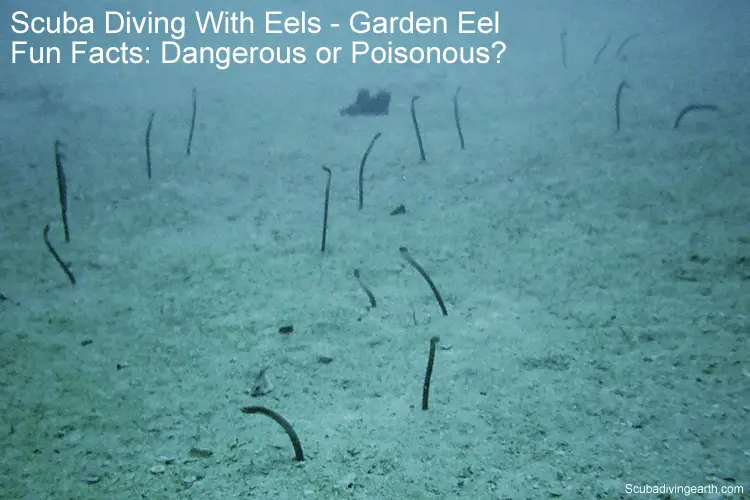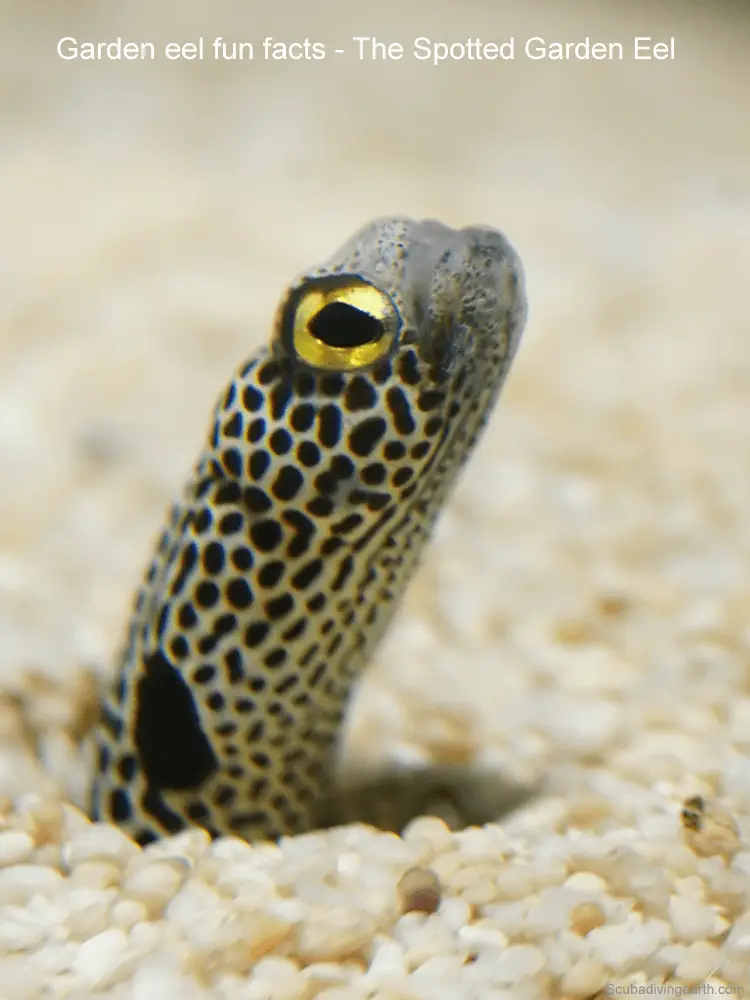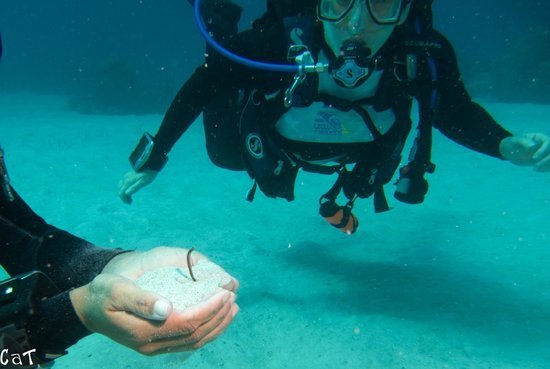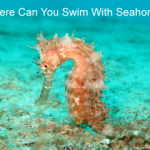Garden eel fun facts from whether they’re dangerous to if they are poisonous…or not

This short article came about after sharing an image from Pinterest of garden eels. These cute little creatures are actually quite fascinating.
Garden eel fun facts include: they are not poisonous and they are not dangerous. Garden eels grow up to 40 centimetres (16 inches) in length. They live in burrows in colonies on sandy bottoms in tropical waters of the Pacific, Indian and Atlantic Oceans. They eat floating zooplankton and are pelagic spawners.
My first encounter with garden eels was in Antigua when I was snorkeling. I remember looking over the sandy bottom, and my first thought was that they were weed sticking up from the sand.
It was only when I approached this wide sandy area that my first thoughts of seeing weed changed. One of the known characteristics of these little creatures is they retreat into their burrows with the first sign of danger. Which in this case the danger was represented by me.
It was this movement that confirmed that these little tube-like-shapes were not weed at all, but instead they were tiny little eels.
The above image is pretty much what I saw that day in Antigua. At first glance you’ll probably agree they look a bit like weed growing from the sand.
The best way to do more diving is to book yourself on a scuba diving liveaboard. You can check the latest and best deals on liveaboards using the following window:
Garden eel characteristics and where to find them
As already mentioned garden eels can be found in the tropical waters of the Caribbean, which for me was in Antigua. I don’t remember seeing them on any of the other islands of the Caribbean, but I doubt they’ll be isolated to Antigua.
Garden eels, which includes the spotted garden eel, live in the warm tropical waters of the world. This includes the Pacific, the Red Sea, the Indian Ocean and the Caribbean sea.
Characteristically, they live in colonies on sandy flats and slopes that border coral reefs.
They tend to live at depths of between 3-45 metres (10-150 feet) deep, which can make it more difficult to see then when snorkeling, unless the water is clear and you’re good at holding your breath.

Garden eel fun facts
Here are a few fun facts about garden eels, beginning with a question I know is asked, which is ‘are garden eels poisonous?’
Are garden eels poisonous?
As far as I can make out, garden eels are not poisonous.
Whilst the spotted garden eel looks like a creature that may have poisonous skin due to the bright colours, this is not the case.
I suggest, as with all sea creatures, you leave them alone in any event. Look but don’t touch. Although I’ve shared a photo from Trip Advisor where a scuba diver has dug-up a garden eel – see below. I don’t suggest you do this.

What is the size of a garden eel and how big do garden eels get?
The size of garden eels depends on the species. There are around 35 species of garden eels. For example, the white ring garden eel reaches lengths of up to a metres ( 3 feet) in length. But this garden eel only lives in the Baja Californian Peninsular.
Spotted garden eels are probably one of the smallest of all the eels in our oceans. They grow to around 40 centimetres (16 inches) in length.
Their bodies have a diameter of about 1.3 centimetres (0.5 inch). So not very big at all.
Do garden eels bite?
To snorkelers and scuba divers the bite of a garden eel is not an issue. Bearing in mind these little creatures only grow to around 40 centimetres (16 inches) long, their mouths are tiny.
However, if you are plankton, that’s a different matter. Garden eels are carnivores and eat plankton.
Also, if you’re a male garden eel, you could find your head and eyes being bitten by a fellow suitor.
In the mating season garden eels move their burrows closer together. This makes it easier for mating, as they are then within reaching distance of each other, including other males.
Once a male picks his female mate, he will defend her viciously. He will bite at the head and even the eyes of any other male garden eel suitors.
Are garden eels dangerous?
Despite the fact that garden eels are in the subfamily Heterocongrinae, or Heteroconger which includes the conger eel family Congridae or congrid eels, they are not dangerous.
Unlike other larger eels, like congers and moray eels, garden eels are not dangerous to humans, as their mouths are simply too small to be a danger.
They are so small and their mouths are tiny, so they could never bite a scuba diver or a snorkeler.
In fact, the these little creatures are very timid when divers or snorkelers approach. They will retreat into their burrows, so even if they were able to bite, they would hide away first in any event.
But as already explained, garden eels are dangerous to you if you happen to be plankton or another male suitor.

Are garden eels endangered?
The garden eels species has not been evaluated to an endangered state.
They are thought to be common and not endangered and are not listed on the red list of endangered species.
What predates on garden eels
Predators that want to eat a garden eels, are those that are able to dig-out the eel from its sandy burrow.
This would include rays and other burrowing sharks, but would also include dolphins. Dolphins have been known to burrow for food in the sand.
Bottlenose dolphins are carnivores, and whilst it’s not certain they eat garden eels, eels do make up part of their diet, as do they with Atlantic spotted dolphins too, which also regularly consume eels.
What do garden eels eat?
A garden eel’s diet is comprised of floating zooplankton, which is brought to them by the ocean’s currents.
Garden eels have good eyesight which enables them to spot their food. This good eyesight is what they also rely onto spot their predators too.
Where do garden eels live?
Spotted garden eels burrow into the sandy sea bottom to make their home. The name ‘garden eel‘ comes from the fact that they form ‘gardens of eels‘. They are mostly found in open areas of sandy bottoms on the edges of coral reefs.
But another favourite habitat of the garden eel is within dense areas of seagrass.
Living amongst seagrass makes it easy for them to blend in with their surroundings, making it more difficult for predators (and scuba divers too) to spot them.
The majority of garden eels live in the Indo-Pacific. But some species are also found in warmer parts of the Atlantic Ocean, which as already mentioned, includes the Caribbean.
They are also found in the East Pacific and off the east coast of Africa.
How do garden eels reproduce?
In the mating season garden eels bring their burrows closer together, which helps them to reach each other to mate.
In reproduction the males and females reach across and entwine their bodies.
Garden eels are mostly ‘pelagic spawners‘, which means that after mating the fertilised eggs are released into the current.
These floating eggs float in the open waters near to the surface until they hatch. Once the baby garden eels are large enough, they swim down and make their burrow. Once they’ve made their burrow they rarely leave it.
However, the white-ringed garden eel uses broadcast spawning. Broadcast spawning is where the female releases her eggs and the male releases his sperm at the same time into the water.
How do they make their burrows?
Garden eels dig their burrow by making their body rigid. They achieve this by tightening their muscles and then drive their pointy tail deep into the sand.
Once the burrow is deep enough, which is deep enough to accommodate the whole length of their body, they are able to hide in the sand from predators.
Once the burrow is deep enough to hide the whole length of their body, they wiggle their dorsal fin to push the excess sand out of the hole. They then secrete slime from their skin, which is what helps to cement the burrow walls and stops them from caving in.
As shown in the above images, they extend only a part of their body out of their burrow. They do this to eat and when they mate, but at the first sign of danger, they will retreat back into the burrow.
Each garden eel lives in its own burrow and will rarely leave its safety once made.
I hope you enjoyed this article about garden eel fun facts
I’d love to hear from you. Tell us about your adventures of diving and snorkeling, in the comments below. Please also share your photos. Either from your underwater cameras or videos from your waterproof Gopro’s!
If this article hasn’t answered all of your questions. If you have more questions either about snorkeling or types of scuba diving (or specifically about garden eel fun facts), please comment below with your questions.
There will also be many more articles about scuba diving (and snorkeling) for you to read and learn about these fabulous sports.
Have fun and be safe!





16 centimeters does not = 16 inches!! It’s more like 6.3 iinches!!
Hello David, thank you for your comment and well spotted – a mistake on my behalf. Actually it was the number of centimetres that was wrong, as these eels can grow to 40 cm, which is the 16 inches. Comments like this are very much appreciated and welcome.
By the way David, you see that I have corrected the error now too 🙂